
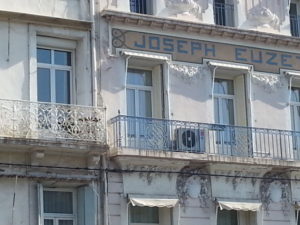

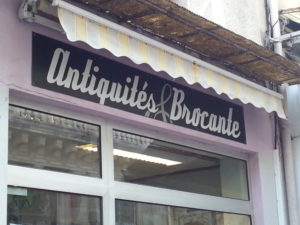
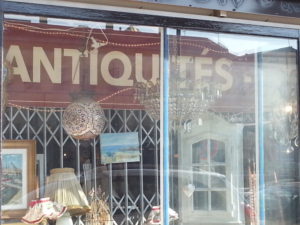 In the pitch black 5am frosty morning I scraped my windscreen and drove to a Marché aux Puces further round the lagoon. This was a regular local market with an array of hum drum plastic and synthetic goods, and yet one or two stalls of interest. Bundled up beneath hat and scarf an elderly man was arranging his collection of metal goods. Among vigneron’s tools and obscure farming equipment stood a 1920’s panel advertising Parapluies Revel in elegant gold lettering which glinted in my torchlight. “Revel is not far from here, towards Carcassone,” he said, “it is where the umbrellas were first made.”
In the pitch black 5am frosty morning I scraped my windscreen and drove to a Marché aux Puces further round the lagoon. This was a regular local market with an array of hum drum plastic and synthetic goods, and yet one or two stalls of interest. Bundled up beneath hat and scarf an elderly man was arranging his collection of metal goods. Among vigneron’s tools and obscure farming equipment stood a 1920’s panel advertising Parapluies Revel in elegant gold lettering which glinted in my torchlight. “Revel is not far from here, towards Carcassone,” he said, “it is where the umbrellas were first made.”
Further along I gathered up a great armful of monogrammed linens and some faded books. On another row a few people pored over an array of items spread out on plastic sheeting. Nothing out of the ordinary here, simply a poignant chronology of a life. A 1940’s wedding day photograph, well used oven dishes, vases, pictures of a chubby, smiling baby, story books, a white patent leather handbag, a bundle of correspondence, scarves, silk flowers…….. “It is an old neighbour of mine.” said the stallholder, “He lost his wife. Now he has to move and he asked me to clear away her things, it was too much for him to do.”
A woman’s voice over a tannoy announced that Brigitte the boulangere had arrived at the gate and was staying for ten minutes only. A small queue gathered at Brigitte’s car boot as she dropped croissants and pastries into paper bags. This was obviously one of her regular Saturday stops.
With some time to spare, I drove to Sete, a hard working port with canals cutting through from the Mediterranean to the lagoon. Rusting fishing boats and smart yachts were moored here. The principal canal was lined with elegant 19th century buildings, balconies and awnings. I spent a contented hour in dazzling February sun at a quayside café.
 Georges Brassens had grown up in Sete. He had wanted to be a poet but became a singer song writer and National treasure. Grainy black and white photographs in the Espace Georges Brassens showed the port as it had been in the 20’s and 30’s.
Georges Brassens had grown up in Sete. He had wanted to be a poet but became a singer song writer and National treasure. Grainy black and white photographs in the Espace Georges Brassens showed the port as it had been in the 20’s and 30’s.
The antiques shop along the quay opened in the afternoon. The owner had a good eye for paintings and I bought a bright canvas of a posy in a jam jar. The painting had been dedicated to him by a Provencal artist. He sighed as he wrapped it up, “I have so many paintings at home, but now I have to sell some….” His son, he told me, had a Brocante just outside of the town and he explained how to get there.
As I walked back to the car I passed Art Deco residences and noticed one named “Remember.” The name had even been incorporated into the white metal gates. The world of old things, memories and times gone by, always inextricably bound together.
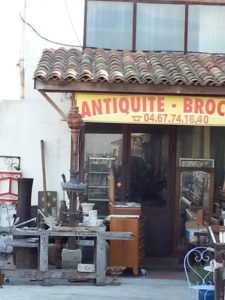 The Brocante was behind wire fencing off a dual carriage
The Brocante was behind wire fencing off a dual carriage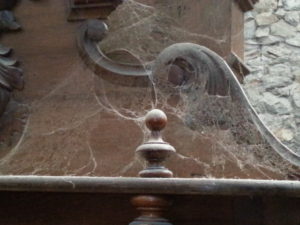 out of Sete. A wind had got up and the metal roof rattled ominously. This warehouse was piled high with heavy, dark and dusty furniture. Monsieur appeared from his little office and wandered round with me. Thick cobwebs were like lace. The spiders here were very large indeed, he said. I came across a painted wooden tabernacle with fringed cream silk curtains and silk lining inside the little door. He told me it came from the church of Saint Joseph in Sete. “It was all I managed to get,” he said me ruefully. By the time he’d heard the church was being renovated the 18th century canvases, blackened with damp at the bottom, had been disposed of, as well as much of the ecclesiastical clothing. Tragic, we both agreed. But the soulful tabernacle came with me.
out of Sete. A wind had got up and the metal roof rattled ominously. This warehouse was piled high with heavy, dark and dusty furniture. Monsieur appeared from his little office and wandered round with me. Thick cobwebs were like lace. The spiders here were very large indeed, he said. I came across a painted wooden tabernacle with fringed cream silk curtains and silk lining inside the little door. He told me it came from the church of Saint Joseph in Sete. “It was all I managed to get,” he said me ruefully. By the time he’d heard the church was being renovated the 18th century canvases, blackened with damp at the bottom, had been disposed of, as well as much of the ecclesiastical clothing. Tragic, we both agreed. But the soulful tabernacle came with me.




